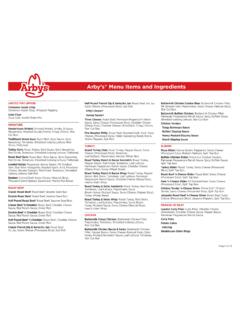Transcription of PICKLES - Food and Agriculture Organization
1 Food and Agriculture Organization of the United NationsPICKLES PICKLES 1. - General information PICKLES are usually made from a mixture of vegetables and fruit. They are eaten as a savoury, spicy accompaniment to a meal. PICKLES are preserved by a combination of increased acidity (reduced pH), added salt, reduced moisture and added spices. PICKLES can be prepared using one of two main methods: lactic acid fermentation of vegetables, either with or without the addition of salt the preservation of vegetables in acetic acid (vinegar).
2 The products made by these two methods are very different -each one has its own distinctive taste and texture. Vegetables such as cucumber, cabbage, olive and onion are fermented by lactic acid bacteria which can grow in low concentrations of salt. The bacteria ferment sugars in the food to form lactic acid , which then prevents the growth of food poisoning bacteria and moulds. The amount of salt added controls the type and rate of the fermentation. If 2-5% salt is used, the fermentation is carried out by a series of bacteria that produce lactic acid .
3 The pickle is preserved by the high level of acidity. If higher levels of salt are used (up to 16%) the product is preserved by the high salt concentration rather than by fermentation and is known as a salt-stock pickle. Fruit and vegetables can be semi-processed and stored for many months by preserving in a high salt solution. They can be further processed into pickle later in the season. Sometimes sugar is added to increase the rate of fermentation or to make the product sweeter. PICKLES prepared by fermentation are not heated, therefore strict attention must be paid to cleanliness and hygiene.
4 The concentration of salt, pH of the mixture and temperature of fermentation must all be controlled to ensure a good fermentation and to prevent the growth of undesirable bacteria. Vegetables pickled in acetic acid (vinegar) have salt and sugar added. They are not fermented an d therefore have a different texture and flavour. 2. - Examples Examples of different types of PICKLES . Reference: Fellows (1997) Product Salt Sugar Vinegar Process Fermented sweet pickle 5% then 3% 1-2% then 3% 0 then 5% Ferment for 1-2 weeks then repacked in vinegar+ salt+ sugar (optional pasteurisation) Fermented sour pickle 5% then 3% 0 then 0 0 then 5% Ferment for 1-2 weeks then repack in vinegar + salt (optional pasteurisation).
5 Unfermented pickle 3% 1% 5% Pack straight away and pasteurise. Salt-stock pickle 15% 0 0 Store until required. Wash out salt and repack as unfermented pickle. 3. - Processing Details Suitability for small-scale production PICKLES are fairly safe products for small-scale manufacturers to make. When preserved properly they carry a low risk of food poisoning and have a long shelf life. PICKLES can be made using relatively simple equipment that is readily available in most places. PICKLES can be prepared from a variety of fruits and vegetables depending on what is available.
6 By varying the proportions of fruit and vegetables and the amount of spice added, a range of products can easily be made. Constraints to production Many small-scale processors choose to make pickle as it is relatively easy. There may be a high level of competition. The conditions for fermentation (temperature, pH and salt content) need to be closely monitored to ensure a good product. The availability of acetic acid may be a problem in some areas. It is essential that a survey is carried out to determine the potential market for the product before starting on production.
7 A successful business depends on a good market for the product. Too often, small-scale processors decide to make PICKLES because there is an abundant supply of raw material, with no evaluation of the demand for the product. These type of ventures usually fail. PICKLES A. -Preparation of the fruit Fruit should be washed in clean water, peeled and the stones removed. Stainless steel knives should be used to cut the fruit into uniform-sized pieces. Most fruits are cut into small strips. Fruit should be as fresh as possible and slightly under-ripe.
8 Damaged, bruised or infected fruits should not be used. Accurate scales are needed to make sure that the correct amounts of ingredients are used each time. Two sets of scales are needed - one with a large capacity for sugar and fruit and a smaller set for the spices. For fermented PICKLES , the peeled fruit and vegetable pieces should be held in a 2-3% salt solution to prevent browning of the surfaces. For non-fermented PICKLES , vinegar, spices and sugar are added before the mixture is heated. Oil is sometimes added to the mixture.
9 Prepared vegetables are placed in the fermentation container and salt or brine is added. The vegetable pieces are weighted down so that they are submerged in the brine. The vegetables and salt are placed in alternate layers until the container is three quarters full. As a guide, 3kg salt are required for every 100kg vegetables. A container with a lid should be used for fermentation. This is to maintain the temperature at the optimum level and to prevent contamination from dust and insects. If brine is being used, a 15-20% brine solution is prepared by dissolving salt in water.
10 This is measured using a salometer or brine hydrometer. A starter culture of juice from a previous fermentation may be added to speed up the fermentation. The temperature and time of fermentation must be carefully controlled. The optimum temperature is 21 C. Fermentation begins as soon as a brine is formed. It can be seen by bubbles of carbon dioxide gas that are given off by the bacteria. Fermentation takes between one and four weeks depending upon the temperature, pH and strength of the salt solution. It is completed when no more bubbles appear.

















